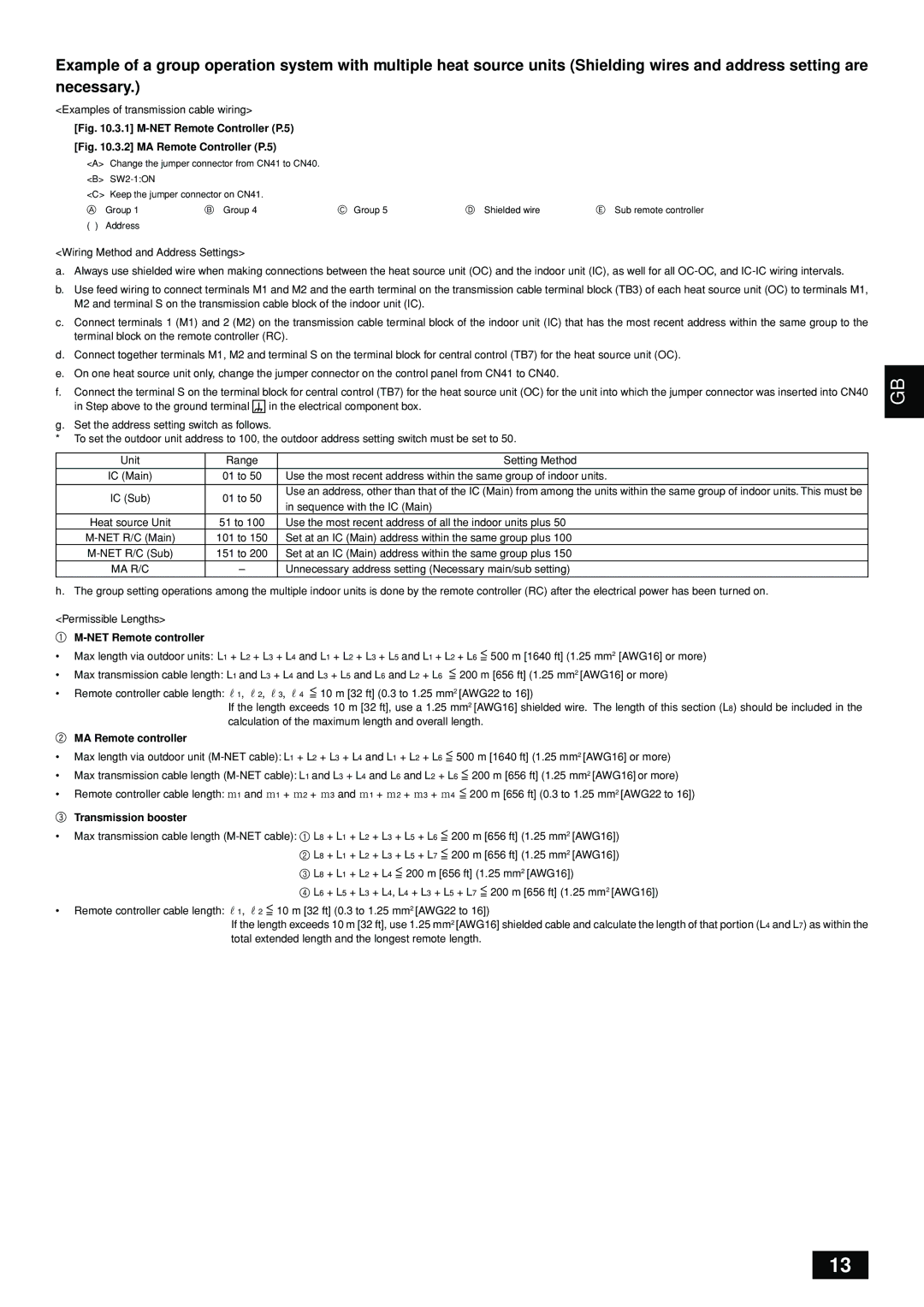
Example of a group operation system with multiple heat source units (Shielding wires and address setting are necessary.)
<Examples of transmission cable wiring>
[Fig. 10.3.1] M-NET Remote Controller (P.5)
[Fig. 10.3.2] MA Remote Controller (P.5)
<A> | Change the jumper connector from CN41 to CN40. |
|
|
| |
<B> |
|
|
|
| |
<C> | Keep the jumper connector on CN41. |
|
|
| |
A Group 1 | B Group 4 | C Group 5 | D Shielded wire | E Sub remote controller | |
( ) | Address |
|
|
|
|
<Wiring Method and Address Settings>
a.Always use shielded wire when making connections between the heat source unit (OC) and the indoor unit (IC), as well for all
b.Use feed wiring to connect terminals M1 and M2 and the earth terminal on the transmission cable terminal block (TB3) of each heat source unit (OC) to terminals M1, M2 and terminal S on the transmission cable block of the indoor unit (IC).
c.Connect terminals 1 (M1) and 2 (M2) on the transmission cable terminal block of the indoor unit (IC) that has the most recent address within the same group to the terminal block on the remote controller (RC).
d.Connect together terminals M1, M2 and terminal S on the terminal block for central control (TB7) for the heat source unit (OC).
e.On one heat source unit only, change the jumper connector on the control panel from CN41 to CN40.
f.Connect the terminal S on the terminal block for central control (TB7) for the heat source unit (OC) for the unit into which the jumper connector was inserted into CN40
in Step above to the ground terminal ![]() in the electrical component box.
in the electrical component box.
g.Set the address setting switch as follows.
*To set the outdoor unit address to 100, the outdoor address setting switch must be set to 50.
Unit | Range | Setting Method | |
IC (Main) | 01 to 50 | Use the most recent address within the same group of indoor units. | |
|
|
| |
IC (Sub) | 01 to 50 | Use an address, other than that of the IC (Main) from among the units within the same group of indoor units. This must be | |
in sequence with the IC (Main) | |||
|
| ||
Heat source Unit | 51 to 100 | Use the most recent address of all the indoor units plus 50 | |
101 to 150 | Set at an IC (Main) address within the same group plus 100 | ||
151 to 200 | Set at an IC (Main) address within the same group plus 150 | ||
MA R/C | – | Unnecessary address setting (Necessary main/sub setting) | |
|
|
|
h. The group setting operations among the multiple indoor units is done by the remote controller (RC) after the electrical power has been turned on.
<Permissible Lengths>
1M-NET Remote controller
•Max length via outdoor units: L1 + L2 + L3 + L4 and L1 + L2 + L3 + L5 and L1 + L2 + L6 = 500 m [1640 ft] (1.25 mm2 [AWG16] or more)
• Max transmission cable length: L1 and L3 + L4 and L3 + L5 and L6 and L2 + L6 = 200 m [656 ft] (1.25 mm2 [AWG16] or more)
•Remote controller cable length: r1, r2, r3, r4 = 10 m [32 ft] (0.3 to 1.25 mm2 [AWG22 to 16])
If the length exceeds 10 m [32 ft], use a 1.25 mm2 [AWG16] shielded wire. The length of this section (L8) should be included in the calculation of the maximum length and overall length.
2MA Remote controller
• | Max length via outdoor unit |
• | Max transmission cable length |
•Remote controller cable length: c1 and c1 + c2 + c3 and c1 + c2 + c3 + c4 = 200 m [656 ft] (0.3 to 1.25 mm2 [AWG22 to 16])
3Transmission booster
•Max transmission cable length
2 L8 + L1 + L2 + L3 + L5 + L7 = 200 m [656 ft] (1.25 mm2 [AWG16])
3 L8 + L1 + L2 + L4 = 200 m [656 ft] (1.25 mm2 [AWG16])
4 L6 + L5 + L3 + L4, L4 + L3 + L5 + L7 = 200 m [656 ft] (1.25 mm2 [AWG16])
•Remote controller cable length: r1, r2 = 10 m [32 ft] (0.3 to 1.25 mm2 [AWG22 to 16])
If the length exceeds 10 m [32 ft], use 1.25 mm2 [AWG16] shielded cable and calculate the length of that portion (L4 and L7) as within the total extended length and the longest remote length.
GB
13
